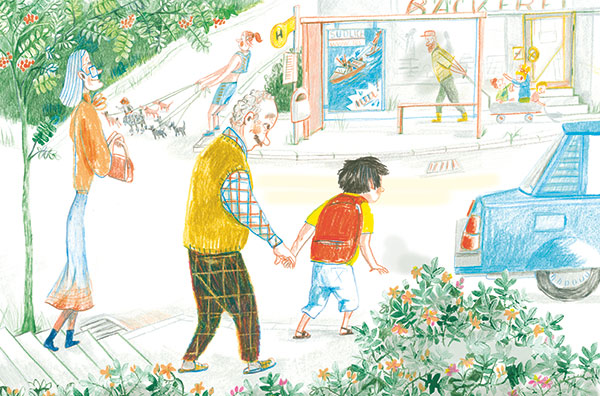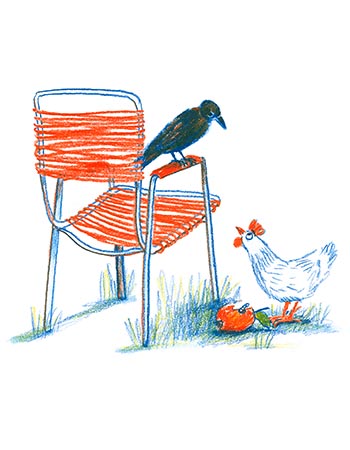Subtotal: $
Checkout
If My Moon Was Your Sun
An author and illustrator explain how music inspired a children’s book about dementia.
By Andreas Steinhöfel and Nele Palmtag
August 21, 2025
An interview with the author and illustrator of If My Moon Was Your Sun, this week’s featured book.
Andreas and Nele, how did you come up with Max?
Andreas Steinhöfel: I can still remember the first image that went through my head. It always starts with an image. Over on one side was a forest with a huge moon behind it, and on the other these little people running around. And it was this little boy I thought of first: a little boy named Max who is running after his grandpa, and who is being followed in turn by this goofy Ms. Schneider. And then you realize: yeah, I think I can make something out of that.
Already a subscriber? Sign in
Try 3 months of unlimited access. Start your FREE TRIAL today. Cancel anytime.
Nele Palmtag: I always find it easier developing the background figures than the main characters. I always find them to be the most difficult – they have to do so much. After that it’s a bit like casting. The basic figure emerges from a feeling, but then I draw fifty heads for Max and decide on one – or at least on a general direction – and then keep developing them. First he’s too old or too young, too fat or too skinny – whatever it is. And I think the fact that you always know someone who reminds you of the character always plays into it, perhaps subconsciously. They always seem familiar to me.

Illustrations by Nele Palmtag.
How did the music influence your writing and illustration?
Andreas Steinhöfel: I listened to the music for months on end, and thought to myself: you have to find a narrative for the feeling that this music awakens in you, one that communicates this emotion to the reader.
Nele Palmtag: I listened to the music and audio narration frequently until I had gotten a sense for myself of who this story is really about. And what I found so incredible was the impression that Andreas and the composer must have sat down together at some point, because everything flows together. I felt that the story is told to the tune of the music, so that the music can take over and continue telling it.
Andreas Steinhöfel: Which is great by the way, as music always brings this two-sided image with it.
Nele Palmtag: My first thought was: man, the music takes up an incredible amount of space. Someone might leaf through the book while listening to the CD, and the images should tell their own story during that time. Of course, the illustrations don’t always recreate the same emotions that I felt: I wanted to stay within the flow of the narrative to answer the question: what happens next?
Andreas, how do you come up with your stories?
Already a subscriber? Sign in
Try 3 months of unlimited access. Start your FREE TRIAL today. Cancel anytime.

Andreas Steinhöfel: I always compare it to a cold glass of lemonade on a summer’s day. You’re sitting outside and, at some point, a layer of condensation forms on the glass. That’s how it is with an image or an idea. After that moment when it first appears, my whole life begins circling this image. And everything that I experience or think of condenses onto this glass. Everything is then scrutinized according to the question: does it fit into the story or not? This drives the people around me crazy. It’s always: oh, Andreas is writing a book (again). But that’s just how it is. And it works, thank God, all by itself. And I always come up with the conclusion first. For me, the conclusion is the light at the end of the tunnel. And then I simply start running towards it. And I might take a thousand detours, and perhaps once I’m finished the light at the end isn’t even in the same tunnel, but at least I had an orientation. That’s how it feels when writing and it was the same here. But in this case the feeling, called forth by the music, was new. I didn’t have a textual idea, I had more of a musical feeling.
Nele, how do you create characters and images?
Nele Palmtag: When I develop characters, I have to establish a biography for each one. So I concern myself with, for example, how the grandfather lived. What does his room look like? What are the characters wearing? And maybe even something like, what is his taste in music? And so on. Generally, I find it easier to illustrate stories that provide fewer images of their own. It was clear to me in this case that I needed to make a stronger effort to interpret the story. For example, Max wakes up in the morning, decides to go, and packs his things. We have no idea yet where this is going to go next. And so I thought: okay, we need a specific context where he is situated. And I don’t want to show him sitting in bed or getting dressed. I don’t want to portray things that are going to happen anyway. Instead I would like to find an image that puts the reader in the same mood that Max is in at the moment. He has to decide what to take on his picnic. And so that’s how I arrived at the picture of the kitchen cupboard.
What is the title, If My Moon Was Your Sun, all about?
Andreas Steinhöfel: The title refers to the fact that Max’s grandfather has dementia, and is slowly losing memory of his life. A black crow appears in nearly every illustration, which acts as a reminder that there is always something dark at work throughout the story – this threatening “Great Forgetting,” as Max calls it, or perhaps, too, the real loss of his grandfather looming in the future. And how do Max and his grandfather deal with this? That is the heart of the story. What happens when light trades places with darkness? Good stories and good illustrations have a certain depth, and it is this depth that draws us to them. It’s not for nothing that we often say that readers “lose themselves” in stories. They have a sort of irresistible attraction. And I hope that we’ve both achieved that here.
Already a subscriber? Sign in
Try 3 months of unlimited access. Start your FREE TRIAL today. Cancel anytime.







